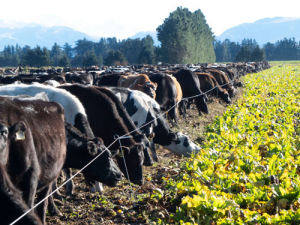TB slaughter levy for dairy jumps 75c/head
TB differential slaughter levy rates are changing with dairy animals paying $12.25/head, an increase of 75c from next month.
 Leaving critical source areas (CSAs) in winter forage paddocks ungrazed over winter helps prevent soil losses and water contamination.
Leaving critical source areas (CSAs) in winter forage paddocks ungrazed over winter helps prevent soil losses and water contamination.
Farmers are being reminded of the importance of leaving critical source areas in winter forage paddocks ungrazed over winter to prevent soil losses and water contamination.
Beef+Lamb New Zealand's Jane Chrystal says the interim results of a Landcare Trust/AgResearch study 'Understanding the impacts of sheep wintering' reinforced the value of leaving critical source areas (CSAs) ungrazed. The CSAs help trap and retain sediment and contaminant run-off resulting from winter grazing.
Under good practice winter grazing management, CSAs - which are low-lying areas within a paddock such as depressions, gullies and swales - should be fenced off and left ungrazed until spring or summer. Ideally, these areas should be left in grass, which acts as an ideal filter and sediment trap.
Chrystal - B+LNZ's principal science advisor, farm systems & environment - says early results from the trial comparing contaminant loss and sediment trapped on similar paddocks, one where the CSAs were grazed while the other was ungrazed, were consistent and significant.
While both paddocks were sown in kale and under a similar management regime of top-down grazing and two breaks of five days, there was a marked difference in the amount of suspended sediment in the water samples collected from each paddock after rainfall events.
Even before analysing the suspended sediment data, the scientists found visually striking evidence of the immediate effectiveness of the CSA on reducing the loss of soils from the paddocks.
The report states that "these visually striking differences provided an immediate indicator that the CSA was having a demonstrable impact on retaining soil and sediments eroded from the uphill portions of the paddock".
Subsequent analysis of the suspended sediments from all rainfall events throughout the winter of 2021 supported these results.
Chrystal explains that the trial, which started in the winter of 2020, is being run on a commercial farm in Waitahuna, West Otago. The goal is understanding the impacts of winter sheep grazing management on several environmental indicators.
"These results highlight the importance of keeping stock away from CSAs during winte and valuing these areas for their ability to prevent soil and contaminant losses."
She encourages all farmers growing winter forage crops to work through the Forage Cropping Management Plan, which is a chapter in B+LNZ's Farm Plan or available as a stand-alone resource.
"This plan will help farmers identify their risks and plan how they will make the best use of their winter feed resources, while protecting their environment and animal welfare."
At Pāmu’s Kepler Farm in Manapouri, mating has wrapped up at the across-breed Beef Progeny Test.
More than 150 people turned up at Parliament recently to celebrate the 20th anniversary of Horticulture New Zealand (HortNZ).
Biosecurity New Zealand says Kiwis should continue to keep an eye out for yellow-legged hornets (Vespa velutina) over the holiday season.
The Push-Up Challenge, an event which combines mental health and fitness, is set to launch in New Zealand in 2026.
Last month's Agritechnica event led to a wide group of manufacturers celebrating successes when the 2026 Tractor of the Year Competition winners, selected by a panel of European journalists, were announced in Hanover Germany.
According to the latest Federated Farmers banking survey, farmers are more satisfied with their bank and less under pressure, however, the sector is well short of confidence levels seen last decade.

OPINION: The release of the Natural Environment Bill and Planning Bill to replace the Resource Management Act is a red-letter day…
OPINION: Federated Farmers has launched a new campaign, swapping ‘The Twelve Days of Christmas’ for ‘The Twelve Pests of Christmas’ to…